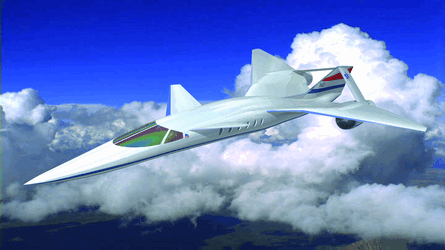Industry and government efforts to develop supersonic business jets (SSBJ) are progressing on the technical side, but face substantial difficulties on the financial front, which is likely to delay efforts to build and test the vehicles.
"Wall Street will offer some unique challenges as we go forward," said Brian Barents, vice-chairman of Aerion at the National Business Aviation Association's annual convention in Orlando this week.
Despite delays in securing a risk-sharing original equipment manufacturer to build and support the aircraft, Barents said the Mach 1.6 eight-passenger twinjet could remain on schedule for first deliveries in 2014 after a five-year development programme if a suitor is found before year's end.
Aerion is reporting 50 orders for the $80 million (2005 dollars), 7,400km (4,000nm)-range aircraft, each secured with a $250,000 refundable deposit. Aerion plans to power its SSBJ with two off-the-shelf Pratt & Whitney JT8D engines, saving $0.5-1 billion in development costs for a new engine.
 |
|---|
Aerion chairman Robert Bass said the aircraft will cost $2.5-3.5 billion to build, with a "major investment" expected from the OEM.
Bass said "detailed discussions" are ongoing with several established aircraft companies on both sides of the Atlantic, with two paths being discussed: the OEM licenses Aerion's technology, including the supersonic natural laminar flow (SNLF) technology that is the linchpin of the aircraft's efficiency or the two form a joint venture. "We're going down one of those two paths," Bass said. "We're not saying which one."
Gulfstream, which continues basic research into sonic boom suppression technologies and has tested patented mitigation techniques using a NASA Boeing F-15B, remains mum on its longer-term plans, except to say that a business case cannot be made for building an aircraft unless US Federal Aviation Administration rules prohibiting supersonic flight over the US mainland are changed, a feat that is likely to require a government-funded demonstrator.
Aerion deals with the issue by using a wing design that flies equally well over the land at just below M1 and over open areas at up to M1.6.
A recent authorisation bill approved by the US Congress on NASA's 50th anniversary hints at programmes in the near future that could solve Gulfstream's quandary. The law approves $406 million to be added to NASA's 2009 aeronautics budget for, among other tasks, conducting supersonic noise studies.
"To have the basis for establishing an appropriate sonic boom standard for such flight operations, a research programme is needed to assess the impact in a relevant environment of commercial supersonic flight operations," the bill says. "The [NASA] administrator shall establish a co-operative research programme with industry, including the conduct of flight demonstrations in a relevant environment, to collect data on the perceived impact of sonic booms that would enable the promulgation of a standard that would have to be met for overland commercial supersonic flight operations."
The downside of the action, however, is that actual funding for the measure will require an appropriations bill that will have to be approved by a Congress and new president strapped by the downstream impact of last week's Wall Street losses.
Meanwhile, Dassault, working with more than a dozen partners under the environmentally friendly high-speed aircraft programme, says the team will complete by mid-2009 the first phase of its effort to evaluate three different SSBJ designs that seek to balance performance and environmental impact.
Design goals include reduced external noise, NOx emission and sonic boom while achieving speeds up to M1.8 and transatlantic range and carrying between eight and 16 passengers. A series of low-speed, transonic and supersonic runs on the three models were carried out at the T-128 facility in Zhukovsky in Russia, Ruag Aerospace in Switzerland and Onera in France. Didier Gondoin, executive vice-president for engineering at Dassault, says the future of the project will be decided after the initial work is finished next year.
Aerion plans to conduct its third and fourth round of low-speed windtunnel tests in October and December at the University of Washington, evaluating planform and engine configuration changes. Previous low-speed tests confirmed the aircraft's 120kt approach speed and ability to operate from 1,830m (6,000ft) runways, says Aerion.
The company will also conduct large-scale tests of engine nozzle configurations designed to meet stage 4 noise requirements. Supersonic tests at the European transonic windtunnel near Cologne, Germany verified laminar flow on the wings up to speeds of M1.35, says Richard Tracy, Aerion's chief technology officer. Although short of the aircraft's M1.6 cruise speed target, Tracy said laminar flow "will become more robust" as speeds increase.
Source: Flight International























